Editor’s Note: The fact that several people are tinkering on their own with the TTS concept verifies two things. First, that tele is far from dead. Secondly, that the future of further progress in the telemark world will be found where the grass roots energy is flowering in spite of the lack of commercial development.
Designing the Mantis
Ever since learning to ski telemark, I have longed for a binding that skis well, is lightweight, has a true free pivot and sports some degree of safety release (allowing skis to come off in the event of an avalanche). The Telemark Tech System promises to meet these requirements. I designed the Mantis binding as a home project to take the TTS concept and to turn it into a binding that could be skied hard on fat skis without concerns about pulling the binding out of the ski.
The Mantis is intended for use primarily in the backcountry, balancing the competing requirements for lightweight and robustness. The Mantis binding is a few grams heavier than the conventional TTS system but more robust in critical areas, reducing the chance of it breaking miles from the trail head. In addition the Mantis was designed to use the same hole pattern as the old (metal) NTN Freeride so that it can be swapped with the Freeride for in-bounds skiing to take advantage of the step in feature and brakes. This is achieved using inserts in the ski and allows the Mantis to be used as a dedicated backcountry / sidecountry tool.
Mantis’ Key Features
The final assembly of the Mantis weighs in at a respectable total 1.2 kg for both feet. This is about 200g (~7 oz.) heavier than a lightweight TTS system and significantly lighter than any conventional free pivot binding available at the time of writing (Jan. ’13). In addition to its light weight, the Mantis combines excellent skiing performance with true free pivot and a release.
Field Performance
The Mantis bindings were tested on a pair of 178cm Wailer-112 DPS and a pair of Lotus 120’s. They have seen pretty much everything from crust to ice to soft groomers and heavy powder (December and January in the Swiss Alps). The Mantis skied very well, combining a smooth flex with no dead spots or inconsistencies with lateral and torsional control on a par with NTN. They have not been tested over big cliff drops and I only weigh in at a mighty 145 pounds. However, they were skied hard on big skis, mostly off the groomers and bounced off a lot of pillows and given a lot of abuse. Bottom line there was no shortage of control for a guy my size driving fat skis.
During general use the binding did not pre-release, but on two occasions (on the first powder run) the bindings did release more easily than expected. Both releases were associated with crashes when the skier went over the tips. Since these initial crashes the bindings have not released. Initially the cause was assumed to be the boot activating the release lever of the Dynafit toe piece, but after close examination it appears more likely to be a vertical release from the toe piece as the skier fell forwards while dragging the tips of the skis behind. This effect was probably compounded by heavy snow.
This behavior is not something that you’d like in a no fall zone but, while irritating to have to click back in, this mechanism would protect well against the accidental hooking of a tree root and would probably release quickly in the event of being caught in an avalanche. On balance it is not a bad thing for a backcountry binding, but is one of the factors that makes this binding a bit fiddly for everyday resort use.
Ease of Use
The Mantis is not the easiest binding to get in or out of. This is its biggest drawback – not that it impacts its intended use as a backcountry binding, but the fiddle factor is the one thing that may prevent people from choosing it for the resort.
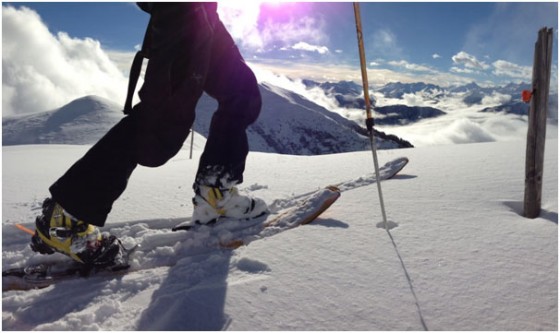
Having a free pivot is the only way to tour and using a Dynafit toe is the best free pivot there is.
Uphill travel is superb due to the low weight and free pivot and buildup of snow was never a problem (on a day when many on NTN were suffering).
Summary
Overall the Mantis delivers on its objectives: it is lightweight, has a free pivot, releases and delivers excellent skiing control. It combines the control of NTN with the smooth flex of a Hammerhead (Axl/Vice). Based on control and flex alone, the Mantis can be skied as an every day binding. Initially I concluded the fiddle factor was too much for resort skiing when compared to NTN with its “step-in” feature and brakes.
Since then I logged two weeks of touring in Canada’s Selkirks with 120mm wide skis. In that time there were no pre-releases, no breakage, and no icing issues. They toured extremely well, and the control is better (less lateral slop) than NTN Freerides. The only minor improvement that I want is to make the cable hook more positively behind the heel post so it is less likely to become unhooked when touring. At this point my preference is for TTS over NTN in-bounds or out.
What’s next?
Since the original design presented above, the Mantis has been modified with a light metal bracket with a pin for the cable pivot. This part is designed to address concerns over possible long term delamination of the carbon fibre riser from the cable attachment and also to provide a support to the boot under the bellows.
This part works well and the Mantis is going to see a simplification of the riser design which will combine with the bracket such that it can be machined in 2 simple parts. Also on the cards are an interface to the new NTN mount patterns and a new version that dispenses with the teleheel and uses the ‘NTN second heel’, tensioned with a front lever so that it is easier to get into / out of. Prototypes of this approach show that the flex feels identical to the heelthrow version, but it will take a bit more time to design a robust, lightweight tensioning mechanism (and to save up for more prototyping).
Conclusion
TTS is a great concept with a lot of potential for further development both in the release, mount and connection to the boot. I hope that it continues to develop as it really could deliver the ‘holy grail’ of telemark bindings.
Design Concepts
(Editor’s note: On the next page Ben examines the forces at work in a telemark tech system. This may help to mollify the analytical unbeliever on the durability and functionality of such a spartan telemark binding. Or not.)
Pages:
- 1
- 2

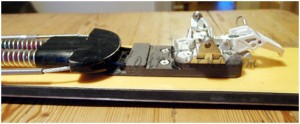
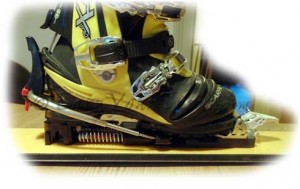
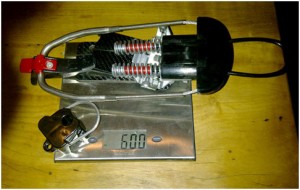
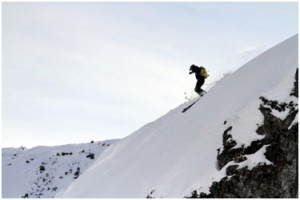
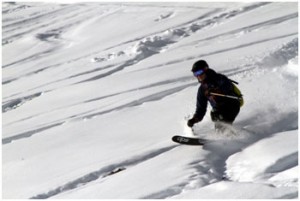
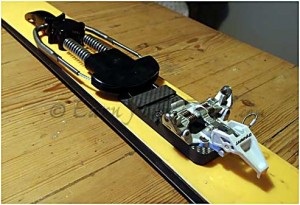
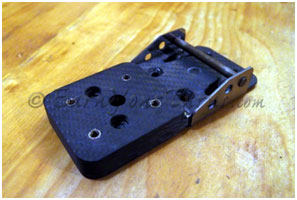
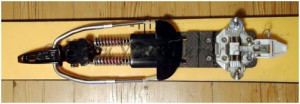
17 comments
1 ping
Skip to comment form
Nice article, thanks.
I like the idea of a carbon fibre mounting plate….
I’ve been skiing with a relatively standard TTS system (direct mounting the tech toe to the ski, G3 heel bits) and really enjoying it.
One thing that I would add to the discussion is the effect of the boot chosen. I suppose this is true for all tele bindings. However, I’m skiing the TTS using an Scarpa F1 AT boot and a current (black/orange) Scarpa TX-Pro (both 27.0). I prefer a more neutral binding so I’ve mounted the block well forward (heel bar 5.25cm back from tech pins). With that same position, the F1s give super-active performance while the TX-Pros provide neutral performance (perhaps similar to a BD O1).
So… just something to consider when mounting your riser blocks. The ideal position for the heel pivot is crucial and you may well want to shift it for different boots. Also, remember that the mount position changes as boot size changes. Test things out before mounting!
Loving it so far.
One other comment that is somewhat off topic – boots that are compatible with TTS (and NTN).
I’m LOVING the light weight, tourability and hikeability of the F1s. It brings me back to the days when tele gear was actually light and a joy to tour in! It is frustrating that the boot manufacturers push the telemark crowd to heavier and heavier gear when the alternatives are obvious. Obviously people will switch to AT when there is a >2kg boot/binding advantage. My F1/TTS setup is as light as any AT setup not using race boots or bindings… I keep hoping to see Scarpa taking the discontinued F1 production line and altering that to come out with a very light NTN/TTS boot. I understand that it is a small market and boot development is very high cost. And, it is somewhat understandable that they delayed until there were lighter touring bindings available. But those bindings are there now. There are issues with the NTN Freedom for touring, but it is moving in the right direction. And TTS is looking pretty good…
Very cool! So this is your design Ben? Couldn’t quite tell from the article.
Regarding the “NTN 2nd heel” version: How about just shortening the wire of an old superloop binding. could this work?
The NTN second heel offers no advantage over using the heel, this has been concluded from more than a few binding makers and frankenbinding makers, the second heel is a gimmick, nothing more. Superloops are too weak, but something with a side throw or a front throw could be incorporated into a TTS.
Oddly, both TTS homebrews were built by Ben’s, but this one was built by Ben, aka Bambi 🙂
Hey Bambi, nice job, very clean and professional. How much does the reinforced plate weigh?
I really enjoyed reading the second page, pretty much the same conclusions I came to during my TTS experiments.
As you found, retention using the NTN second heel (duckbutt) holds no advantage over retention using the standard heel, it was a gummick that caught the eye of many telemarkers, but we now know that it is nothing more than a gimmick.
NTN did bring the AT toe and tech fittings into tele mainstream, for hat we can be very grateful. I have been skiing TTS hybrids and TTS for two years. I have had no binding failures, no binding pull outs, and I have had numerous releases.
Simply put, TTS works, TTS is the future.
The difference may also be due to the location of the tech fittings on the F1 vs the TX Pro, the F1 has the fittings located for improved touring. Also, the F1 has shorter bellows travel, so it’ll bottom out faster, which could make it feel more active when in fact it’s simply run out of travel.
No, it isn’t bottoming out. The F1 boot/binding system is stiffer right at the start – and remains so through the flex of the boot. I believe it is related to your first point – that the race boots have a short sole and, I believe a slight set-back of the tech fittings. Therefore, it is the essentially the same effect of using a significantly smaller boot – it shifts the pivot point of the riser blocks further back – making the binding/boot combo more active. I think the new F1 flex is actually stiffer as well. So the combination of those two things make it a more active combination compared toa pair of softer, well-used, larger soled TX-Pro.
My point is that the performance of the system is sensitive to many things. That isn’t bad – but it does complicate setting things up. It also suggests that having movable spring pivot points is critical for a production binding.
@ TTYS – Yes this is a design that I put together last summer. I had been tinkering with test rigs for quite a while but was motivated to spend some money prototyping after seeing Ben K’s ‘Dyna AXL’ on this site. I’ll make it clearer on the article.
@Ben K – The riser weighs 92g per binding. That weight is the price you pay for the more robust mount + the ability to use it in the NTN mount pattern.
@telemarkman – a short cable works like a charm for the second heel while skiing but it does have the disadvantage of not disengaging as cleanly and so you need more travel on the preload to ensure that it disconnects for tourmode. I have not yet decided whether to go with the cable or a solid claw.
@PQ – I am very interested in the F1 as a much lighter boot option – can they drive larger skis or are they limited to lighter weight gear? I’m also wondering how much flex the TLT5 has in the toes, and whether that could be easily modified to allow more flex – I have not got my hands on a pair to see what limits it’s range of motion. If possible then it strikes me that a TLT5 boot could probably provide almost as much control as a TX_pro with a 1.4 kg weight saving.
Ben
Cutting weight is tough as the heavy parts (springs, cables/wires, toe piece) are constants, so then if you start adding brakes, a quick throw in/out release, it quickly adds up. Teleskier is correct, NTN has the “convenience” apects covered, but at that convenience comes some costs: higher weight, fragility, and lower performance. Which is why the TTS needs to stay like it is, simple, durable and light.
The one thing that I feel is not mentioned enough is release. Sure, there are releasable telemark bindings, but they are either clunky or suffer from poor performance. NTN is not releasable, though some claim to have releases, it is still not a releasable binding, nor was it designed to release. TTS on the other hand does have a toe piece designed to release and it will release, as it has for me more than a dozen times. Given time, there will be a toe piece designed with an adjustable release!
The potential for TTS is huge! The ability to design a toe around a true free pivot, where release and retention can be seperated, and where the retention can be varied by user preference (underfoot cable, side mount wires), these are things that NTN cannot do in it’s current iteration.
Toe boxes are so yesterday 🙂
hi,
i think it will work with a hammerhead to, if you cut the 75 norm wings off and install the techtoe on top of the plastic shim. now you have 5 cablepins to move the force of the binding.
i’ll do this when i get a tech boot with bellows cheep.
greets from snowing munich
matsch
Hi Matsch,
ich arbeite seit zwei Jahren an einer TTS Lösung mit der Option das Fersenteil der Dynafit auch für alpines Fahren und Steighilfe zu nutzen. Das Ergebnis kann ich villeicht schon beim tf-skitest in Tux zeigen. Hast du Interesse an einem Gedankenaustausch? Wohne auch in MUC. Schau Dir mal den Beitrag über meinen Prototyp bei tf-friends an.
Gruß
Heino Jahn
Sorry for my first Reply in German. I am working for two years realizing a TTS including the Dynafit Heelpiece to have two options: Tele and/or Alpine. News and Pics soon on Facebook.
Greetings also from Munich
Heino
Any chance of
I’d like to get also a TTS plate but how to!?
Are there any news on this binding or what is happening to the wasatchski-company’s TTS? It seems they are still on beta-models and i cannot find the bindings in stores. I totally agree with the pros of the Mantis concept! Anyway of getting hold of those CAD-models for milling? 😛 That’d be excellent squared! Keep up the good work.
[…] makes it ripe for a host of DIY variations, some of which have been publicized on this website (Mantis). And Spike continues to attract interest, again, for simplicity and functionality. The biggest […]